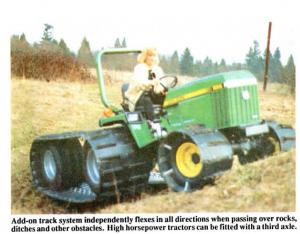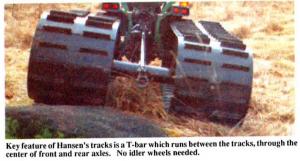Low-Cost Way To Belt Wheel Tractors
"It gives you the advantages of Caterpillar's Challenger for a fraction of the cost," says David Hansen, Ridgfield, Wash., inventor of a revolutionary T-bar suspension system for converting conventional wheel tractors to run on belted rubber tracks.
David's prototype, unveiled at the recent Northwest Ag Show in Portland, got a rousing reception from farmers and others who foresee exciting applications for this firstof-its kind track conversion system.
"What we have here is an American-built 1990 Deere 955 hydrostatic drive diesel with 4-wheel drive and 33 engine horse-power," David told farm show visitors. "We removed the rear wheels and installed our belted tracks, turning this particular wheel tractor into a go-anywhere all-terrain vehicle. In snow or rugged mountain terrrain, it'll keep up with machines costing upwards of $100,000. You can buy this rig for only $25,000 and that includes the brand new tractor."
Many farmers who saw it felt the prototype on display would be great for spraying or planting. "With hydrostatic drive, you're always in the right gear. And, with the belted tracks, you can move right through mud or standing water. What's more, you have a deluxe tractor-powered sprayer, as opposed in many cases to an underpowered ATV equipped with a motorcycle engine," David points out.
He feels that while most standard wheel tractors can be equipped with Hansen tracks, the best candidates are those with 4-WD. On larger horsepower tractors, a third axle can be added to "beef up" the tracks for heavy loads. Converting a tractor to run on belts doesn't curtail its ability to handle either pull type or 3 pt. equipment. A wide variety of carrying equipment can be mounted on top the tracks, such as a large spray tank, cargo box, fertilizer hopper or, for snow or mountain country, an 8-passenger "people carrier" cab.
The key feature of Hansen's tracks is a patented (pending) T-bar which runs between the tracks, and right through dead center of the front and rear axles. The bar, tied to a large spring coil and hydraulic cylinder, automatically tensions the tracks (eliminating the need for idler wheels) and gives the tracks complete freedom to independently flex in all directions when passing over boulders, steep ditches and other obstacles. be added.
Hansen uses industrial belting to manufacture the tracks. "It comes in a variety of grades and sizes, allowing you to pick and choose to best suit each application. The prototype, for example, is belted with tracks made from industrial belting made for potato conveyers. It comes in 30 in. widths. We cut it down to 28 in.," David points out.
At present he's only offering his tracks on new tractors which he buys and converts on special order. In year or two, he hopes to have kits available which farmers can buy to "belt" existing tractors.
For more information, contact: FARM SHOW Followup, David Hansen, 15905 NE 31st Ave., Ridgefield, Wash. 98642 (ph 206 573-2093).

Click here to download page story appeared in.
Click here to read entire issue
Low-Cost Way To Belt Wheel Tractors TRACTORS Conversions 15-2-21 "It gives you the advantages of Caterpillar's Challenger for a fraction of the cost," says David Hansen, Ridgfield, Wash., inventor of a revolutionary T-bar suspension system for converting conventional wheel tractors to run on belted rubber tracks.
David's prototype, unveiled at the recent Northwest Ag Show in Portland, got a rousing reception from farmers and others who foresee exciting applications for this firstof-its kind track conversion system.
"What we have here is an American-built 1990 Deere 955 hydrostatic drive diesel with 4-wheel drive and 33 engine horse-power," David told farm show visitors. "We removed the rear wheels and installed our belted tracks, turning this particular wheel tractor into a go-anywhere all-terrain vehicle. In snow or rugged mountain terrrain, it'll keep up with machines costing upwards of $100,000. You can buy this rig for only $25,000 and that includes the brand new tractor."
Many farmers who saw it felt the prototype on display would be great for spraying or planting. "With hydrostatic drive, you're always in the right gear. And, with the belted tracks, you can move right through mud or standing water. What's more, you have a deluxe tractor-powered sprayer, as opposed in many cases to an underpowered ATV equipped with a motorcycle engine," David points out.
He feels that while most standard wheel tractors can be equipped with Hansen tracks, the best candidates are those with 4-WD. On larger horsepower tractors, a third axle can be added to "beef up" the tracks for heavy loads. Converting a tractor to run on belts doesn't curtail its ability to handle either pull type or 3 pt. equipment. A wide variety of carrying equipment can be mounted on top the tracks, such as a large spray tank, cargo box, fertilizer hopper or, for snow or mountain country, an 8-passenger "people carrier" cab.
The key feature of Hansen's tracks is a patented (pending) T-bar which runs between the tracks, and right through dead center of the front and rear axles. The bar, tied to a large spring coil and hydraulic cylinder, automatically tensions the tracks (eliminating the need for idler wheels) and gives the tracks complete freedom to independently flex in all directions when passing over boulders, steep ditches and other obstacles. be added.
Hansen uses industrial belting to manufacture the tracks. "It comes in a variety of grades and sizes, allowing you to pick and choose to best suit each application. The prototype, for example, is belted with tracks made from industrial belting made for potato conveyers. It comes in 30 in. widths. We cut it down to 28 in.," David points out.
At present he's only offering his tracks on new tractors which he buys and converts on special order. In year or two, he hopes to have kits available which farmers can buy to "belt" existing tractors.
For more information, contact: FARM SHOW Followup, David Hansen, 15905 NE 31st Ave., Ridgefield, Wash. 98642 (ph 206 573-2093).
To read the rest of this story, download this issue below or click
here to register with your account number.








